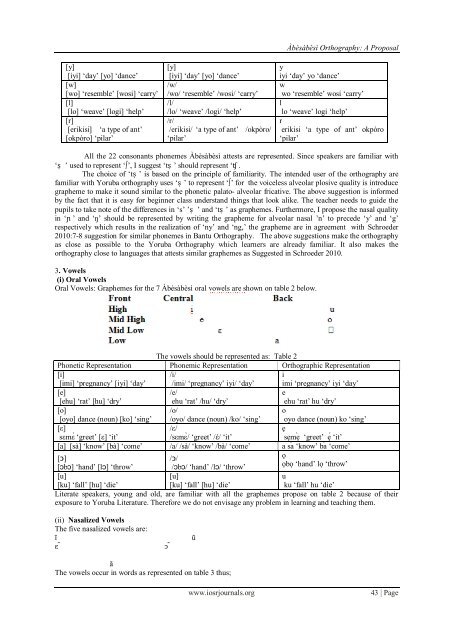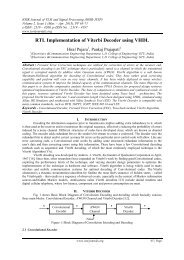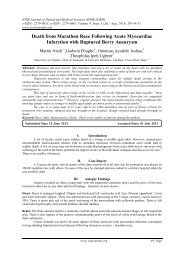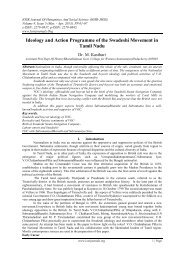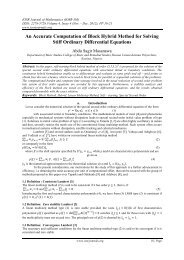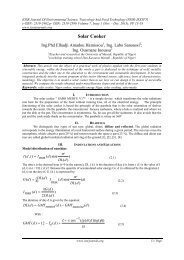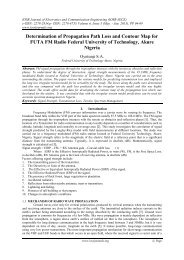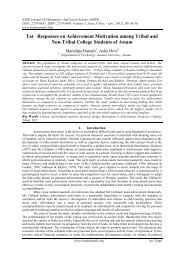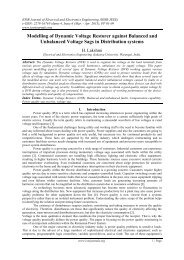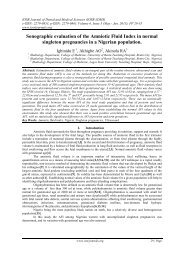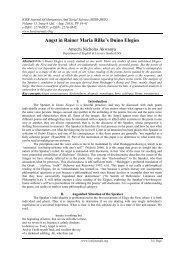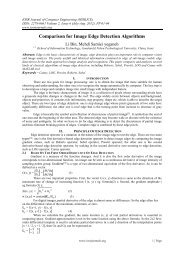Design Compatibility of Classroom Furniture in Urban and ... - IOSR
Design Compatibility of Classroom Furniture in Urban and ... - IOSR
Design Compatibility of Classroom Furniture in Urban and ... - IOSR
Create successful ePaper yourself
Turn your PDF publications into a flip-book with our unique Google optimized e-Paper software.
[y]<br />
[iyi] ‘day’ [yo] ‘dance’<br />
[w]<br />
[wo] ‘resemble’ [wosi] ‘carry’<br />
[l]<br />
[lo] ‘weave’ [logi] ‘help’<br />
[r]<br />
[erikisi] ‘a type <strong>of</strong> ant’<br />
[okpòro] ‘pilar’<br />
[y]<br />
[iyi] ‘day’ [yo] ‘dance’<br />
/w/<br />
/wo/ ‘resemble’ /wosi/ ‘carry’<br />
/l/<br />
/lo/ ‘weave’ /logi/ ‘help’<br />
/r/<br />
/erikisi/ ‘a type <strong>of</strong> ant’ /okpòro/<br />
‘pilar’<br />
Àbèsàbèsì Orthography: A Proposal<br />
y<br />
iyi ‘day’ yo ‘dance’<br />
w<br />
wo ‘resemble’ wosi ‘carry’<br />
l<br />
lo ‘weave’ logi ‘help’<br />
r<br />
erikisi ‘a type <strong>of</strong> ant’ okpòro<br />
‘pilar’<br />
All the 22 consonants phonemes Àbèsàbèsì attests are represented. S<strong>in</strong>ce speakers are familiar with<br />
‘ṣ ’ used to represent ‘∫’, I suggest ‘tṣ ’ should represent ‘ʧ .<br />
The choice <strong>of</strong> ‘tṣ ’ is based on the pr<strong>in</strong>ciple <strong>of</strong> familiarity. The <strong>in</strong>tended user <strong>of</strong> the orthography are<br />
familiar with Yoruba orthography uses ‘ṣ ’ to represent ‘∫’ for the voiceless alveolar plosive quality is <strong>in</strong>troduce<br />
grapheme to make it sound similar to the phonetic palato- alveolar fricative. The above suggestion is <strong>in</strong>formed<br />
by the fact that it is easy for beg<strong>in</strong>ner class underst<strong>and</strong> th<strong>in</strong>gs that look alike. The teacher needs to guide the<br />
pupils to take note <strong>of</strong> the differences <strong>in</strong> ‘s’ ’ṣ ’ <strong>and</strong> ‘tṣ ’ as graphemes. Furthermore, I propose the nasal quality<br />
<strong>in</strong> ‘ɲ ’ <strong>and</strong> ‘ŋ’ should be represented by writ<strong>in</strong>g the grapheme for alveolar nasal ’n’ to precede ‘y’ <strong>and</strong> ‘g’<br />
respectively which results <strong>in</strong> the realization <strong>of</strong> ‘ny’ <strong>and</strong> ‘ng,’ the grapheme are <strong>in</strong> agreement with Schroeder<br />
2010:7-8 suggestion for similar phonemes <strong>in</strong> Bantu Orthography. The above suggestions make the orthography<br />
as close as possible to the Yoruba Orthography which learners are already familiar. It also makes the<br />
orthography close to languages that attests similar graphemes as Suggested <strong>in</strong> Schroeder 2010.<br />
3. Vowels<br />
(i) Oral Vowels<br />
Oral Vowels: Graphemes for the 7 Àbèsàbèsì oral vowels are shown on table 2 below.<br />
The vowels should be represented as: Table 2<br />
Phonetic Representation Phonemic Representation Orthographic Representation<br />
[i]<br />
[imi] ‘pregnancy’ [iyi] ‘day’<br />
/i/<br />
/imi/ ‘pregnancy’ iyi/ ‘day’<br />
i<br />
imi ‘pregnancy’ iyi ‘day’<br />
[e]<br />
[ehu] ‘rat’ [hu] ‘dry’<br />
/e/<br />
ehu ‘rat’ /hu/ ‘dry’<br />
e<br />
ehu ‘rat’ hu ‘dry’<br />
[o]<br />
[oyo] dance (noun) [ko] ‘s<strong>in</strong>g’<br />
/o/<br />
/oyo/ dance (noun) /ko/ ‘s<strong>in</strong>g’<br />
o<br />
oyo dance (noun) ko ‘s<strong>in</strong>g’<br />
[ε]<br />
sεmὲ ‘greet’ [ε] ‘it’<br />
/ε/<br />
/sεmὲ/ ‘greet’ /έ/ ‘it’<br />
ẹ<br />
sẹmẹ̀ ‘greet’ ẹ́ ‘it’<br />
[a] [sà] ‘know’ [bà] ‘come’ /a/ /sà/ ‘know’ /bà/ ‘come’ a sà ‘know’ bà ‘come’<br />
[ɔ]<br />
/ɔ/<br />
ọ<br />
[ɔbɔ] ‘h<strong>and</strong>’ [lɔ] ‘throw’<br />
/ɔbɔ/ ‘h<strong>and</strong>’ /lɔ/ ‘throw’<br />
ọbọ ‘h<strong>and</strong>’ lọ ‘throw’<br />
[u]<br />
[ku] ‘fall’ [hu] ‘die’<br />
[u]<br />
[ku] ‘fall’ [hu] ‘die’<br />
u<br />
ku ‘fall’ hu ‘die’<br />
Literate speakers, young <strong>and</strong> old, are familiar with all the graphemes propose on table 2 because <strong>of</strong> their<br />
exposure to Yoruba Literature. Therefore we do not envisage any problem <strong>in</strong> learn<strong>in</strong>g <strong>and</strong> teach<strong>in</strong>g them.<br />
(ii) Nasalized Vowels<br />
The five nasalized vowels are:<br />
ĩ<br />
ԑ ̃<br />
ɔ ̃<br />
ũ<br />
ã<br />
The vowels occur <strong>in</strong> words as represented on table 3 thus;<br />
www.iosrjournals.org<br />
43 | Page


